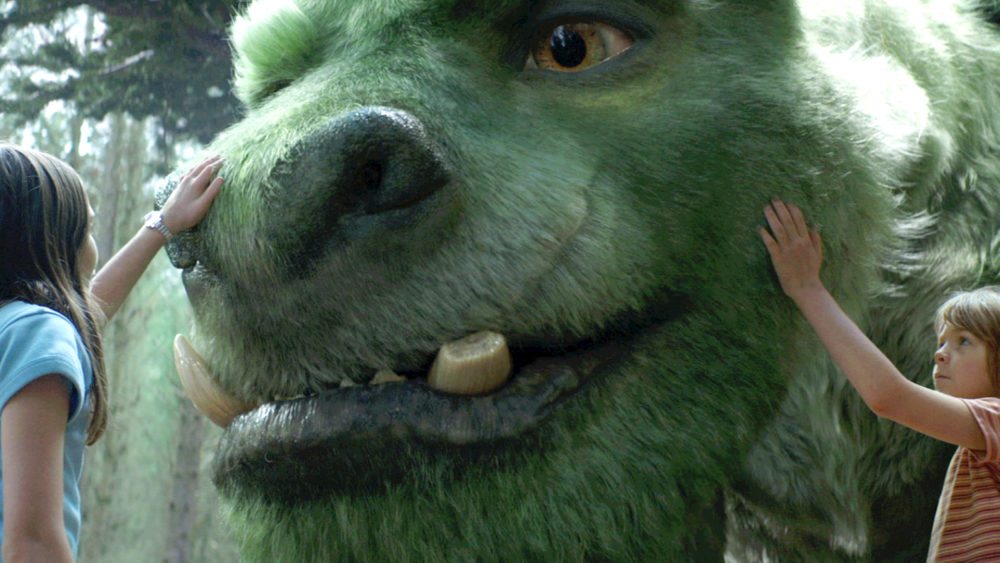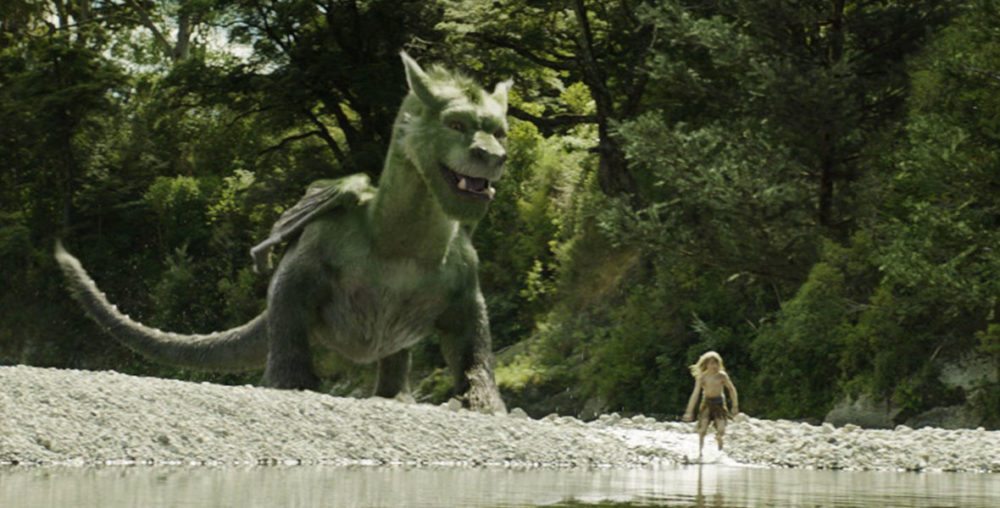The wave of Disney’s “live-action remakes” is showing no signs of slowing down. And love ’em or hate ’em, you can’t deny that most of them have been pure eye candy. They’re just stunningly gorgeous. (Fantastic stories and phenomenal acting just make them even better.) And Pete’s Dragon – which is out today on Digital HD, blu-ray, Disney Movies Anywhere, DVD, and On-Demand – is no exception. Check here for our review of the film when it first hit theaters.
The Blu-ray includes some fun special features, including a behind-the-scenes featurette narrated by director David Lowery who reads from the personal diary he kept during production. Also included are featurettes devoted to the special effects; Elliott’s character design; a couple music videos; a blooper reel; and an audio commentary with Lowery, co-writer Toby Halbrooks, and the film’s two child actors: Oakes Fegley and Oona Laurence.
We had a chance to sit down with David Lowery and chat about his experiences on the film, his history with the original Pete’s Dragon, and how this big studio film compared to the independent films he’s more used to making. We also talk about shared universes and why these live-action remakes don’t all exist in one.
GeekDad: Did you have a history with the original Pete’s Dragon? Was it part of your childhood?
David Lowery: You know, to be honest, it wasn’t. It was a movie that I saw once when I was 6 or 7 years old, but beyond that it wasn’t one of those movies I forced my parents to sit through over and over again. So when I come on board this version of it, I came almost with a completely fresh perspective. I didn’t really remember the original that well, and I decided not to go back and revisit it, so I could approach this one completely fresh.
GD: Oh, interesting. So you didn’t even go back to see how the story was treated there?
DL: I didn’t, because I knew I wanted to tell my own story. I didn’t want to be beholden to expectations of what a remake of the original might be like. I didn’t want to have the original in mind, even. I really just wanted to start with a tabula rasa and make a new version of Pete’s Dragon for a new generation.
GD: How difficult was it to come up with a character design for Elliott that resembled the original but was still suitably unique?
DL: There were some things about the original design that I thought were great. I love that he’s a clumsy dragon. I love that he’s not sleek and “cool looking.” And I like that he has a big jaw. Big jaws are something that I find aesthetically appealing, so I wanted to maintain that big lower jaw. (laughs) But I didn’t go overboard trying to make him too close to the original. . . . And I will say that, just for fun, we had a photo-real rendition of the original Elliott made just to see what it would look like. And it’s terrifying. It really does not carry over well into three dimensions, and it’s hilarious and awful all at the same time. We realized very quickly that, even though we were already on the path to a new Elliott, we definitely didn’t need to go back to that.
GD: In the wake of franchises such as How to Train Your Dragon and The Hobbit, with larger-than-life dragons, how hard was it to find a new design that didn’t seem derivative of what audiences have already seen?
DL: I didn’t think about it all that much. I tried to cast out all other dragons from my mind and think about it from a character perspective. I tried to think, if you were a 5-year-old who was lost in the woods and came upon a monster, what would it need to look like so you’d feel safe with it right away? Because we need Pete to feel safe right away. And that led to certain design choices like him being furry, which was one of the very first decisions I made. . . . We found that there are certain things he had to have to remain a dragon. If we took the same Elliott and put feathered wings on him, he would no longer be a dragon but a griffin. And once you understand the rules [of the character], it’s just a matter of playing around with it until you find the right version. . . . I really wanted his head to be bigger than it should be so it would hang a certain way. You end up making choices like that in the interest of the story and the emotions of the story, and you end up with a unique dragon.
GD: I read a bit of your blog, and one thing that you’ve written about repeatedly is the need to disconnect from the Internet and reviews and whatnot when a new film comes out. Why is that?
DL: I get obsessive about it. It’s very hard for me to have a fair and balanced approach to reading what people write about my own work. I love criticism. I think film criticism is a wonderful art form, and the act of criticism in general I endorse wholeheartedly. I hope that it remains a viable way for people to make a living in spite of the drastic cuts to the editorial parts of our newspapers. But I personally found with my last film that I got too obsessive about it. I would read everything. Good reviews would make me feel pretty good, but then I would read a bad review and it would just monopolize my week. I couldn’t sleep at night. I’d wonder why I didn’t make better choices. It was a four-month period where I felt mentally unstable because I was just reading too much about my own work. And it didn’t help me. It didn’t make my life better to know there were good reviews. It just made everything worse because I was focusing on the bad ones. So with this movie, I thought the healthy thing to do would be to disengage. As soon as the second trailer came out this past summer, I got off the Internet as much as I could. I did read the first Variety review, and I thought, “well, it’s not getting any better than that, so I’m just stopping.” So I successfully managed to not obsess about it this time around.
GD: You also wrote that making Pete’s Dragon was in many ways very similar to making small, independent movies. You wrote, “On indie movies, you have to search for financing and on studio movies, you have to manage notes from upstairs.” In retrospect, do you prefer either of these “necessary travails,” as you call them?
DL: No. There’s not at all. I’m making another movie in the spring, which we had to find financing for, and it’s a pain. It sucks. But you do it, and the flipside is I’m writing a script I have carte blanche with. With Pete’s Dragon, we kind of did have carte blanche. The studio wanted us to tell the story we wanted to tell. But because they’re a big company that has to turn a quarterly profit, they need to make sure it’s the kind of movie they can release and that audiences will go see. So that process of collaboration with a studio is not something I’m used to, but it was very productive and positive. I enjoyed it. But I don’t have a preference. If a movie needs to be a studio movie, if it needs to have all the things that a studio can provide, then I will happily go through that process. If the movie can survive as an independent film, then I’ll go look for the money and figure that out.
GD: We’re in the middle of a time when sprawling cinematic universes are popular. Do you know if there was ever talk of somehow making all of the live-action remakes part of one shared universe? Did you ever get artistic direction to “kind of make it feel like the ones that have come before so it feels similar”?
DL: No, none whatsoever. And taking things in a further direction, we weren’t even aware of [specific decisions made during the production of] The Good Dinosaur or The Jungle Book. We didn’t know anything about them. So when the trailer for The Good Dinosaur came out, we were like, “Wait a minute, that kind of looks like our movie.” And then The Jungle Book trailer came out, and we said, “Oh man, it’s another kid in a loincloth running through the woods.” But there was no directive to make it look like anything other than we wanted it to look like. We had a very clear vision for the movie, and the studio supported that. They wanted it to be our movie. We joke all the time about the “shared universe” idea. It’s a constant running joke.
With the script I’m writing right now [Peter Pan], we constantly joke about how we can bring in other characters from the Disney universe. Ultimately, though, I’m really glad they’re not doing that because it allows movies to exist on their own. I think that’s a valuable thing. The Marvel movies are great; I love that shared universe. But when I see other studios trying to preplan that sort of thing? I hope Universal makes a great series of Universal Monsters movies, but I don’t really know if I want to see a movie in which Frankenstein and Dracula and the Creature from the Black Lagoon are all fighting evil together. That’s not that appealing to me. Maybe it will be amazing, but I’m glad Disney is not so gung ho about shared universes. Hopefully Marvel can stay its own thing…and we won’t see a crossover Marvel/Star Wars universe. That’d be a bummer.





